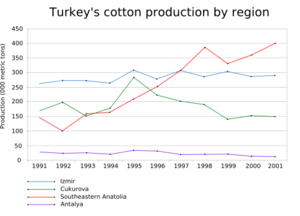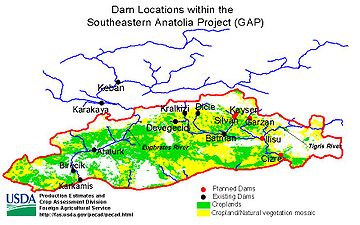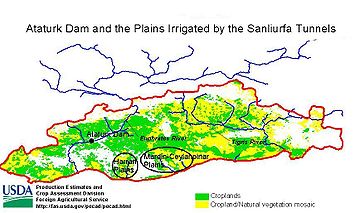| Revision as of 03:40, 24 November 2005 editDavenbelle (talk | contribs)3,206 editsm →External links and sources← Previous edit | Revision as of 03:45, 24 November 2005 edit undoDavenbelle (talk | contribs)3,206 editsm sp: Ceterpiece -> Cenerpiece; Irigation -> Irrigation; contraversial -> controversialNext edit → | ||
| Line 51: | Line 51: | ||
| ===Dams=== | ===Dams=== | ||
| ] | ] | ||
| '''Southeastern Anatolia Project''' consists of 21 Dams: | '''Southeastern Anatolia Project''' consists of 21 Dams: | ||
| #] - Hydroelectric, Irigation | #] - Hydroelectric, Irigation | ||
Revision as of 03:45, 24 November 2005

The Southeastern Anatolia Project (Turkish: Güneydoğu Anadolu Projesi) or GAP is the dam/irrigation project consisting of a series of 21 dams on the Tigris and Euphrates rivers primarily to be constructed in the south eastern region of Turkey. The project is expected to be completed by 2010 and the total cost of the project is estimated at $32 billion USD.
Strategic goal
Historically, Southeastern Anatolia was located on the trading route between east and west. Region had been an important source of cultural diversity. However the changes in the trading routes and the agricultural methods ended the old importance of the region.
The project aims to initiate the revitalization of the economic, social and cultural life in the region. GAP is an "integrated regional development project". The rise in the income of the region directly transferred to restoration and revitalization of the cultural activities in the region.
- 1908 - Farmland 1908 - Farmland
-
 1908 - Irrigation
1908 - Irrigation
-
 1908 - Well and a girl
1908 - Well and a girl
- 2004 - Greenhouse 2004 - Greenhouse
- 2004 - Restoration activities 2004 - Restoration activities
Social Impact
The GAP occupies eight provinces in Southeastern Anatolia (Adıyaman, Batman, Diyarbakır, Gaziantep, Siirt, Şanlıurfa, Mardin, and Şırnak).
The primary objective of GAP is to normalise levels of development, income, and living standards between the southeastern region and other regions of Turkey. Creating economic and social opportunities and promoting business, GAP is transforming the region completely. Critical infrastructure, such as airports and highways, is being constructed to support the development of the region. GAP will provide jobs to an estimated 3.5 million people directly.
Economic development
Irrigation


GAP is estimated to double Turkey's irrigable farmland. The increase of agricultural activity of GAP in its incomplete state is visible clearly on the USDA graph above. Cotton production increased from 150,000 metric tons to 400,000 metric tons, making the region the top cotton producer.


GAP will create 17,000 square kilometres (4.2 million acres) of farmland in the Harran plain alone, as visible on two USDA maps above.
Reports indicate due to irrigation from the Atatürk Dam have tripled harvest yields of cotton, wheat, barley, lentils, and even other grains in the Harran plain. A number of Agriculture Department backed innitiatives are encouraging farmers to experiment with new varieties of fruits, vegetables, and nuts that did not exist in the region prior.
As a result of GAP, land values, personal income, number of agricultural and personal vehicles of course has increased, even have tripled in the past eight years.
Fishing
GAP is been built at a region where water used to be a scarce. With the vast number of lakes beeing formed, plans of using them as a breeding space of comercial fishing is also underway. At the case of Atatürk Dam fishing industry in the region is already developing.
Power
The GAP also consists of 17 hydroelectric power plants. These will supply the energy equivalent of 22% of the anticipated total nationwide energy consumption in 2010. Providing 8,900 gigawatt hours (32 PJ), it is one of the largest series of hydroelectric power plants in the world.
Infrastructure
Dams

Southeastern Anatolia Project consists of 21 Dams:
- Atatürk Dam - Hydroelectric, Irigation
- Batman Dam
- Birecik Dam
- Devegeçidi Dam
- Dicle Dam
- Karakaya Dam
- Karkamış Dam
- Keban Dam
- Kralkızı Dam
- Ilısu Dam - Hydroelectric - (contraversial)
Maintenance
The reason for the sheer number of dams in the project, more than would at first appear needed, is maintenance. Dams need to be cleaned from the debris carried with the water flow. After a while the dam becomes obsolete as water flow slows down to inadequate levels. The dams will be shut down every 5 to 10 years for fall maintanance (also called fall cleanup). Water levels are normally lowest in fall. The extra dams are placed in service during this maintenance period.
In cases of natural disasters such as floods, the maintenance may be performed earlier. The plan is to have one or two dams spare in case an emergency shutdown of any dam is necessary. While shutting down a dam also shuts down irrigation channels linked to it, it can nevertheless continue providing power.
Engineering behind the project

Providing electricity and irrigation is challenging in a region as large as the one targeted by GAP. A constant flow of water is imperative.

Once a constant rate of flow is available, the water can be diverted to flow through water turbines to create alternating current, which can be channeled to cities across considerable distances. The energy dissipitator (left) is the water flowing off of the turbines which are not visible but are embedded in concrete. However electricity is only part of the usage of the tons of water collected at the dam.

When dealing with tons of water, it has to be distributed evenly and slowly. Occasionally main channels will need maintenance, or may be damaged due to external reasons. In order to even asses the problem, tons of water need to be removed from the main channel. The best way to do this is to slow the overal flow from the main dam and redirect all water flowing originally through the damaged channel to backup channels. Radial gates serves this purpose, they regulate the flow of water. It is imperative to keep water flowing. Lack of the flow will not only comprimise all irrigation linked to that channel but also all cities linked will experience a power outage.

After leaving the energy dissipitator, water flows into a set of main channels, which flow in different directions supplying water to a greater area. They are the most critical part of a dam project aside from the dam itself. This is as critical as high-voltage transmission lines in power grids.

Sluice gates regulate the flow of water. If water flows too fast it will overflow and probably damage one or more of the channels, or flood irrigation fields. Multiple sluice gates regulate the speed of the flow on different sections of the channel. They can also be used like radial gates to cut water in channels.



After leaving the radial gates on the main channel, water flows to canals which are smaller and can carry less water. Flow regulators divert water on canals to distribution canals. Just like radial gates and sluice gates, flow generators can stop water flow if necessary. Distribution canals are the last step as far as engineers are concerned. It delivers water to different sections of large fields, pretty much an artificial river.



It is up to farmers to get the water from distribution channels to their crops for irrigation. There are different methods to do this; any one or a combination of earth distribution channel, furrow, and drip tubes can be used.
Status of GAP
| Status of the project as of June 2000 | |||
| Completed | Ongoing | Planned | |
| Power capacity MW |
4,490 | 898 | 1,947 |
| Power production MW (GWh/yr) |
1,906 (16,704) | 375 (3,286) | 812 (7,119) |
| Irrigation area km² |
2,121.97 | 1,591.47 | 14,286.56 |
| Number of dams | 12 | 2 | 8 |
| Number of hydropower plants | 6 | 2 | 10 |
According to many estimates, the GAP's completion date of 2010 is unlikely to be achieved. Some dams, such as the one closest to Hatay, are long overdue for fall maintenance. Since the start of its construction the project was hampered by various issues ranging from diplomatic problems and economic crises to terrorism.
Tensions between Turkey, Syria and Iraq were raised from time to time due to GAP. Syria and Iraq demanded more water to be released, while Turkey declined so as to form the dam lakes. Because of this GAP is one of the world's most well protected dam projects, especially against aircraft.
GAP almost came to a complete halt in the early 1990's due to the high level of Kurdistan Workers Party (PKK) activity in the region. The PKK is not only blamed for a number of funding cuts as funds were diverted to support the counter-terrorism effort, but is also blamed for damaging several dams and canals, as well as killing engineers working at the dams.
A number of economic crises also played a very important part in the delays of GAP.
Finally, a number of judicial questions needed clearing over the flooding of several historical sites as well as local residences as described in the Social Impact section.
Cultural Impact
| The neutrality of this section is disputed. Relevant discussion may be found on the talk page. Please do not remove this message until conditions to do so are met. (Learn how and when to remove this message) |
Completion of the Ilısu Dam would cause the flooding of the ancient city of Hasankeyf whose history stretches back over 10,000 years. Investigations by the Kurdish Human Rights Project (KHRP) found a
- widespread perception that the GAP project, and Ilısu in particular, is motivated primarily by a desire to destroy the Kurds as an ethnic group by destroying their most important cultural sites.
Between 50 and 68 hamlets and villages will be flooded affecting approximately 25,000 local people. An additional 57 villages will have their land partially flooded.
Many villages have reportedly been evacuated at gunpoint by the Turkish authorities, and in many cases houses have been burnt to the ground.
Erasure of Displaced Peoples
The GAP has been criticized for the fact that the damming the regional rivers will flood a significant portion of the historical Armenian and Kurdish homelands, effectively erasing the cultural and archaeological history of those displaced peoples. Further controversy results from the fact that the events of the Armenian Genocide, recognized by a wide array of international scholars but officially denied by Turkey, were geographically concentrated in the region that is to be flooded. Critics point out that the dam could effectively erase the evidence of ancient Kurdish and Armenian habitation in the region.
See also
External links
- www.gap.gov.tr - Official GAP web site
- www.un.org.tr/undp/Gap.htm - United Nations Southeast Anatolia Sustainable Human Development Program (GAP)
- www.gapturkiye.gen.tr/english/current.html Current status of GAP as of june 2000
- www.ecgd.gov.uk Data sheet
- www.turkishembassy.org/governmentpolitics/issuesgap.htm
- www.khrp.org/publish/p1999/IlisuReport.htm The Ilısu Dam - A Human Rights Disaster in the Making
- Re-Emergence of Discredited Ilısu Dam Project
- http://www.ilisu.org.uk/ Ilısu Dam Campaign